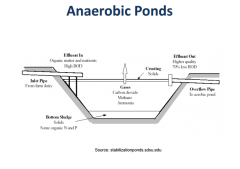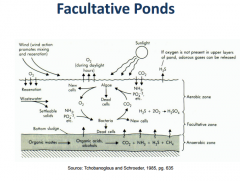![]()
![]()
![]()
Use LEFT and RIGHT arrow keys to navigate between flashcards;
Use UP and DOWN arrow keys to flip the card;
H to show hint;
A reads text to speech;
18 Cards in this Set
- Front
- Back
|
waste stabilisation ponds Advantages |
-low capital cost and easy to design -low operating and maintenance cost -high level pathogen kill -robust system -can deal with load fluctuations due to long retention periods. - resource recovery via algae harvest -bio-gas generation in anaerobic ponds |
|
|
waste stabilisation ponds disadvantages |
-large land area requirement -inconsistent nutrient removal -lack of engineering process control -performance influenced by climate |
|
|
Types of ponds |
- anaerobic -facultative -maturation |
|
|
Anaerobic |
-first pond in series -high organic loading -40-70% BOD removal -2-5m deep, no algae |
|
|
Anaerobic pond |

|
|
|
Facultative pond |
- most common pond type - primary or secondary pond - 1.5m depth - contains anaerobic and aerobic zones. |
|
|
faculatative pond |

|
|
|
Maturation pond |
- last in series - polishing treatment - pathogen and nutrient removal - 1.5m deep |
|
|
Pond treatment: Organics |
-Primary settling occurs in the first pond
- they get anaerobically decayed in sludge layer |
|
|
Pond treatment: pathogen removal |
- high pathogen removal Due to - long retention time -high PH -Exposure to sunlight -Oxygen presence -competition by microbes |
|
|
Pond treatment: Nitrogen and phosphorus removal |
-60-80% removal -removed by assimilation, biological nitrification/denitrification, settlement an removal of solids -chemical precipitation at high ph -biological uptake by algae |
|
|
anaerobic pond design |

|
|
|
Facultative pond design |

|
|
|
maturation pond design |

|
|
|
Wetlands advantages |
- low capital and operating cost - ease of operation - minimal mechanical and electrical components |
|
|
types of wetlands |
1. surface flow 2. sub-surface flow |
|
|
surface flow |
-water passes through stem of plants. - larger than subsurface flow wetland. |
|
|
Subsurface flow |
-water passes through media and past root zone-Aesthetically pleasing |

